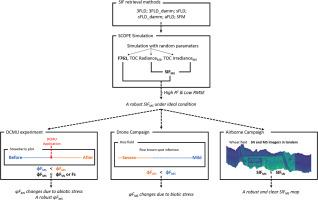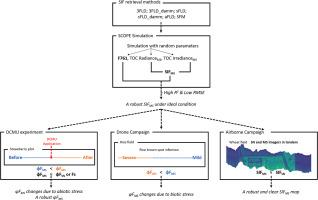Detecting plant physiological changes under stress using sun-induced chlorophyll fluorescence from mid-spectral resolution imagery
IF 11.4
1区 地球科学
Q1 ENVIRONMENTAL SCIENCES
引用次数: 0
Abstract
Sun-induced chlorophyll fluorescence (SIF) serves as a valuable indicator for remote sensing of plant physiology. Recent studies have shown that far-red SIF at 761 nm (hereafter SIF) from mid spectral resolution (SR) imagers (3–7 nm full width half maximum (FWHM)) derived reliable fluorescence emission in relative levels. Such mid SR based SIF (SIFMS; the subscript MS refers to mid SR basis) has been extensively utilized for assessing fluorescence variability in precision agriculture and plant stress detection across various platforms. However, the uncertainties regarding the ability of SIFMS to detect physiological SIF yield (ΦF) remain inadequately investigated. Here, we evaluated various retrieval techniques (i.e., Fraunhofer line depth (FLD), its variant methods, and spectral fitting method (SFM)) under theoretical condition (SCOPE simulation), stress condition (DCMU experiment at field level and rice brown spot disease detection at drone level), and at airborne level employing mid SR (3–7 nm FWHM) and sub-nanometer SR (< 0.2 nm FWHM) sensors. Under theoretical conditions, the SIFMS derived from aFLD, 3FLD and SFM showed strong linear relationships with the simulated fluorescence at 761 nm (R2 > 0.9; RMSE <0.5 mW m−2 nm−1 sr−1). With data collected under stress conditions, however, only the SFM method captured the stress-induced physiological changes in the field-ΦFMS (p-value <0.05) and from the drone-ΦFMS (p-value <0.05; R2 = 0.51). SFM also produced a robust and clear map of airborne-SIFMS (SIFMS = 1.03 x SIFSN + 0.48 where the subscript SN refers to sub-nanometer SR). Conversely, 3FLD and aFLD methods yielded a limited ability to adequately detect the physiological changes in field-ΦFMS (p-value>0.05) and drone-ΦFMS (p-value <0.05; R2 ≤ 0.15) and exhibited a noticeable stripe noise in the airborne-SIFMS map. Our finding demonstrated that mid SR imagery with SFM has the potential to track crop ΦF changes induced by stresses.


利用太阳诱导的叶绿素荧光中光谱分辨率图像检测胁迫下植物的生理变化
太阳诱导的叶绿素荧光(SIF)是一种有价值的植物生理遥感指标。最近的研究表明,中光谱分辨率(SR)成像仪(3-7 nm全宽半最大值(FWHM))在761 nm处的远红色SIF(以下简称SIF)获得了相对水平的可靠荧光发射。这种基于中SR的SIF (SIFMS,下标MS为中SR基)已被广泛应用于各种平台上的精准农业荧光变异性评估和植物胁迫检测。然而,关于SIFMS检测生理SIF产率的能力的不确定性(ΦF)仍然没有得到充分的研究。在此,我们评估了各种检索技术(即弗劳恩霍夫线深度(FLD),其变化方法和光谱拟合方法(SFM))在理论条件下(SCOPE模拟),应力条件下(田间水平的DCMU实验和无人机水平的水稻褐斑病检测),以及在空中水平使用中SR (3-7 nm FWHM)和亚纳米SR (< 0.2 nm FWHM)传感器。在理论条件下,由aFLD、3FLD和SFM得到的SIFMS与模拟荧光在761 nm处表现出很强的线性关系(R2 > 0.9; RMSE <0.5 mW m−2 nm−1 sr−1)。然而,对于在应力条件下收集的数据,只有SFM方法捕获了野外-ΦFMS (p值<;0.05)和无人机-ΦFMS (p值<;0.05; R2 = 0.51)应力引起的生理变化。SFM还生成了一个强大而清晰的空气-SIFMS图谱(SIFMS = 1.03 x SIFSN + 0.48,其中下标SN表示亚纳米级SR)。相反,3FLD和aFLD方法在充分检测野外-ΦFMS (p值>;0.05)和无人机-ΦFMS (p值<;0.05; R2≤0.15)的生理变化方面的能力有限,并且在机载sifms地图中显示出明显的条纹噪声。我们的发现表明,使用SFM的中SR图像有可能跟踪作物ΦF由胁迫引起的变化。
本文章由计算机程序翻译,如有差异,请以英文原文为准。
求助全文
约1分钟内获得全文
求助全文
来源期刊

Remote Sensing of Environment
环境科学-成像科学与照相技术
CiteScore
25.10
自引率
8.90%
发文量
455
审稿时长
53 days
期刊介绍:
Remote Sensing of Environment (RSE) serves the Earth observation community by disseminating results on the theory, science, applications, and technology that contribute to advancing the field of remote sensing. With a thoroughly interdisciplinary approach, RSE encompasses terrestrial, oceanic, and atmospheric sensing.
The journal emphasizes biophysical and quantitative approaches to remote sensing at local to global scales, covering a diverse range of applications and techniques.
RSE serves as a vital platform for the exchange of knowledge and advancements in the dynamic field of remote sensing.
 求助内容:
求助内容: 应助结果提醒方式:
应助结果提醒方式:


